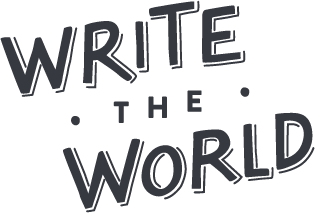Community member Thenjiwe Cakwebe asks: “When a writer gets the excitement to write a certain story how do they keep the drive to write it? I’ve been having those drives to write but I end up losing interest.” This prompted gathering all of our resources on how to overcome writer's block into one blog and guide!
A: Whether it’s writer’s block or a new story idea that pulls you from the page, it’s tempting, at times, for us writers to drop our plotlines and paragraphs mid-way through a project. Although there’s nothing wrong with abandoning one idea in favor of another, there is a certain satisfaction in sticking with a story from start to finish, feeling pride in a completed product. Here are some suggestions for those moments when you’re looking to “keep the drive to write.”

1. Contribute to Your Writing Community
At Write the World, we already belong to a ready-made community of caring, interested people who understand the joys and pains of the writing process. When we feel our energy waning, sharing our struggle with others, or publishing drafts-in-process for peer-review, can help kick us back into action.
Maybe a writer in Australia will propose a shift in your opening paragraph, or a reader in Pakistan will ask a question that causes a breakthrough in your thinking about characterization? Because writing is an iterative process (meaning non-linear, cyclical, requiring many versions, or iterations), talking with others at all stages of the creative process can provide community and camaraderie when you need a boost. So, submit for peer-review; participate in a contest; or comment on others’ work to connect with writers around you.

Because it’s nice to share productivity with others face-to-face, you may also consider supplementing your involvement on Write the World with opportunities to meet writers in your part of the world. Seek out critique groups or writing clubs. See if your local library offers writing workshops. Find a friend who likes to write, and offer to be one another’s “beta readers” (people who agree to read authors’ works-in-progress and provide feedback). You can swap drafts and discuss, meet up for designated writing times, or keep each other committed and accountable to producing a certain number of words each month (or week, or day).
2. Focus on Process, Not Product
Sometimes, when we lose motivation to work on a draft, it can mean that self-doubt has crept into our craft. We’re imagining our ideal end-product, worrying that we just won’t get there, comparing our words to those of a favorite author (or the person sitting next to us in English class).
To quell and calm that inner critic, at least until it comes time to edit, focus on process using the following tips:
- Freewrite. Set a timer for 1 minute, 10 minutes, an hour—and keep your pen moving. Write down every sentence you think of. Not sure what to write? Writing “I’m not sure what to say. I don’t have any ideas. I’m hungry and bored” can be an interlude that will give way to—pop!—your next plotline. Author Natalie Goldberg stands by this practice, insisting that the constant flow of words onto paper without pause fosters creativity.
- Card-sort. Ever seen crime shows where detectives stick Post-It notes across a corkboard, strings and pins connecting their clues? That’s kind of like card-sorting a novel. The next time you’re feeling stuck regarding the structure of your story, take out sticky notes or index cards and write out your characters, conflicts, or chronology. Practice organizing, swapping, and reorganizing the order of each story element, just like David Gerrold, author of the Star Trek episode, “The Trouble with Tribbles,” who talks about card-sorting in this article.
- Sketch. From character portraits to setting maps, plot diagrams to infographics, for those who are visually or artistically inclined (or just like putting marker/pen/paintbrush to paper), exploring story elements through a different artistic medium can help unlock puzzling parts of the drafting process. Close your story document and turn to the sketchpad for a new approach to revitalizing your draft— your sketches might even make their way into an illustrated final product, like our new Writers on Earth anthology!
- Trust the Process! Writing can be a long, meandering, challenging process requiring much patience and endurance. Roald Dahl writes:
“When you’re writing it’s rather like going on a very long walk, across valleys and mountains and things, and you get the first view of what you see and you write it down. Then you walk a bit further, maybe up on to the top of a hill, and you see something else, then you write that and you go on like that, day after day, getting different views of the same landscape. The highest mountain on the walk is obviously the end of the book because it’s got to be the best view of all, when everything comes together and you can look back and see everything you’ve done all ties up. But it’s a very, very long slow process."

Whereas the writing you do in school requires you to work efficiently towards a deadline, against the guidelines of an assignment, pursuing creative work on your own often requires much more patience, more room for “process.” Remember to celebrate each valley and mountain on your journey, embracing it as integral to your creative path.
Looking for more in this vein? See How to Use AI to Beat Writer's Block!
3. Set a Deadline or Work Towards a Goal
There’s nothing like a deadline to keep you glued to your chair, banging out your word count before the clock strikes. Healthy pressure can conjure creativity and ensure that you stick with the story you’ve started.
To create this healthy pressure for yourself, submit to a monthly Write the World competition (pro tip: you can find the genres of all upcoming comps to get a head-start on your draft); pitch a story to an online literary journal; perform a poem at a local open mic; or self-publish a story collection to share with friends and family. Adhering to a deadline or goal will allow you to “keep your eyes on the prize” when you’d rather feed the cat, clean your room, procrasti-bake cupcakes… (a.k.a. not write!)

4. “Read, Read, Read.”
It was William Faulkner who said, “Read, read, read. Read everything… and see how they do it. Just like a carpenter who works as an apprentice and studies the master. Read! You’ll absorb it. Then write.”
Reading provides wonderful ignition for regaining inspiration to write. There’s nothing like soaking in elegant turns of phrase, or perfectly paired stanzas, to fire you up and return you to your work with deepened vision. When you’re looking to “keep the drive to write it,” turn to writers who inspire you. Study not only the stories, but the techniques (imagery, opening lines, presence of dialogue) that call to you as a reader. What resonates with you might denote your own style and voice as a writer, or open your mind to new strategies you can incorporate into your work.

5. Keep a File of “Half-Drafts”
While the above strategies can sometimes save you from mid-project doldrums, it’s true that there are times when, and stories for which, we just can’t find the creative power to keep going—and that’s O.K.! Be sure to keep a folder of your “half-drafts”—those manuscripts you’ve abandoned partway.
Someday, you may find unexpected inspiration and return to them with renewed insight, or perhaps you’ll realize that five stories were attempting to tell the same plotline and you can combine them into a novella.
Creativity has a way of striking us in quiet, unrelated moments (washing the dishes, going on a walk, taking a shower), so keep a pen and pad of paper handy, and don’t discard those drafts you’ve deemed unfit to finish.





